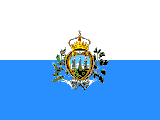San Marino
| Conventional short name: | |
| Local: | San Marino |
| English: | San Marino |

| |
| National motto: Libertà "Liberty" | |
| Languages: | |
| Official: | Italian |
| Others: | Emiliano-Romagnolo Neapolitan |
| Cities: | |
| Capital: | San Marino |
| Largest: | Dogana |
| Other: | Borgo Maggiore Seravalle Domagnano |
| Area: | 61 sq. km |
| Population: | ca. 28,000 citizens (2006 |
| Independence: | from Roman Empire |
| Date: | 3 Sept. 301 |
| Currency: | lira |
| Organizations: | European Federation |
San Marino is one of Europe's oldest republics, with General Council having first been in session in the 8th century. It is also one of the smallest countries in Europe.
Administration
Government
The people of San Marino elect one representative from each of their castelli (regions) to make up the General Council. The General Council elects one of its members as a president every six months. The current president is Gian Argente from Chiesanuova.
Administrative Divisions
San Marino has nine administrative divisions, called castelli (singular castello). Each castello is composed of one major, central town and a number of smaller towns.
- San Marino
- Acquaviva
- Borgo Maggiore
- Chiesanuova
- Domagnano
- Faetano
- Fiorentino
- Montegiardino
- Serravalle
History
In 301, Marinus of Rab, a stonemason fleeing religious persecution, settled in San Marino. He later became Saint Marinus, and he continues to be San Marino's patron saint. Since that time, with relatively few interruptions, San Marino has maintained its independence, first by being out of the way, and eventually under papal decree. When Italy was officially federated in 1933, San Marino held a referendum to decide whether or not it would join Italy, which was rejected by 83% of the voting population.
Geography
San Marino is an enclave within Italy. As one of the smallest countries in Europe, it feels close ties of size, if not necessarily in culture, to Grand Fenwick and Saugeais.
Borders
The only country that San Marino borders is Italy. To the north, it borders the nation of Romagna and to the south, the Marches.
Economy
San Marino's economy is primarily based on tourism, but the country also produces some wine and cheese, which it exports, mostly to Italy and Two Sicilies. Other than that, its main industries are off-shore banking and revenue from stamp sales (Sammarinese stamps are only valid in San Marino, and are thus more of a collector's item than a practicality; for most mail, the Sammarinese use Italian postage, with the consent of the Italian government).
San Marino is part of the European Federation currency union. The largest denomination of its currency is the lira (plural lire), which is equal to 20 soldi (singular soldo), which are equivalent to 240 denari (singular denaro).
Culture
San Marino's culture is generally very similar to its neighbor, Italy.
Languages
Unlike Italy, where regional languages are favored over the state language, the Sammarinese feel a connection to their national language, Italian, which is generally disliked in Italy. The local language, a dialect of Emiliano-Romagnolo, is fairly widely spoken as well, though in recent years, unlike in Italy, it has become increasingly displaced by Italian. There is also a small but vocal Sicilian minority in San Marino, and so the Neapolitan language is becoming more prevalent.
Religion
Like its neighbor, Italy, San Marino is overwhelmingly Roman Rite Catholic.
See also
- Italy: San Marino's neighbor.
- European Federation: the currency union to which San Marino belongs.